Blog & Latest Updates
Fly Fishing Articles
Insects by Common Name


Mayfly Genus Epeorus (Little Maryatts)
Taxonomic Navigation -?-
Kingdom
Animalia (Animals)
» Phylum
Arthropoda (Arthropods)
» Class
Insecta (Insects)
» Order
Ephemeroptera (Mayflies)
» Genus Epeorus (Little Maryatts)
9 species aren't included.
Common Names
The best Epeorus hatch in the East is Epeorus pleuralis, the famous Quill Gordon, the first abundant large mayfly hatch of the year. Epeorus vitreus comes a little later and is important in both the East and Midwest.
In the West, Epeorus longimanus dominates in fast, high-altitude streams, while Epeorus albertae inhabits slower and lower waters.
Hatching Behavior
All Epeorus duns emerge from their nymphal shucks (
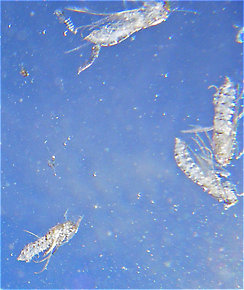
Here's an underwater view of the pupal shucks of several already-emerged Brachycentrus numerosus caddisflies.
Spinner Behavior
Female Epeorus spinners oviposit by making repeated dips to the surface. They deposit a few eggs, sometimes rest briefly, and then take off for another run.
Nymph Biology
Most Epeorus species require fast, pure water flowing over gravel or boulders. Some can inhabit moderate currents.
Pictures of 52 Mayfly Specimens in the Genus Epeorus:
Male Epeorus pleuralis (Quill Gordon) Mayfly Dun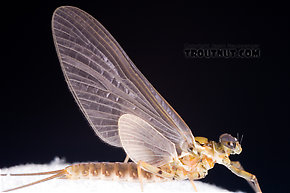 View 9 PicturesI kept this specimen after photographing it and it molted into a spinner in perfect condition, which I photographed here.
View 9 PicturesI kept this specimen after photographing it and it molted into a spinner in perfect condition, which I photographed here.
 View 9 PicturesI kept this specimen after photographing it and it molted into a spinner in perfect condition, which I photographed here.
View 9 PicturesI kept this specimen after photographing it and it molted into a spinner in perfect condition, which I photographed here.Collected April 30, 2007 from Dresserville Creek in New York
Added to Troutnut.com by Troutnut on May 3, 2007
Added to Troutnut.com by Troutnut on May 3, 2007
Male Epeorus pleuralis (Quill Gordon) Mayfly Spinner View 10 PicturesI spent (Spent: The wing position of many aquatic insects when they fall on the water after mating. The wings of both sides lay flat on the water. The word may be used to describe insects with their wings in that position, as well as the position itself.) most of the day looking for Epeorus pluralis duns or spinners without any luck on the major Catskill rivers. Finally in the evening I arrived at a small stream somebody had recommended, and when I got out of the car I was happy to find that I had parked in the middle of a cloud of male spinners.
View 10 PicturesI spent (Spent: The wing position of many aquatic insects when they fall on the water after mating. The wings of both sides lay flat on the water. The word may be used to describe insects with their wings in that position, as well as the position itself.) most of the day looking for Epeorus pluralis duns or spinners without any luck on the major Catskill rivers. Finally in the evening I arrived at a small stream somebody had recommended, and when I got out of the car I was happy to find that I had parked in the middle of a cloud of male spinners.
 View 10 PicturesI spent (Spent: The wing position of many aquatic insects when they fall on the water after mating. The wings of both sides lay flat on the water. The word may be used to describe insects with their wings in that position, as well as the position itself.) most of the day looking for Epeorus pluralis duns or spinners without any luck on the major Catskill rivers. Finally in the evening I arrived at a small stream somebody had recommended, and when I got out of the car I was happy to find that I had parked in the middle of a cloud of male spinners.
View 10 PicturesI spent (Spent: The wing position of many aquatic insects when they fall on the water after mating. The wings of both sides lay flat on the water. The word may be used to describe insects with their wings in that position, as well as the position itself.) most of the day looking for Epeorus pluralis duns or spinners without any luck on the major Catskill rivers. Finally in the evening I arrived at a small stream somebody had recommended, and when I got out of the car I was happy to find that I had parked in the middle of a cloud of male spinners.Collected April 19, 2006 from Mongaup Creek in New York
Added to Troutnut.com by Troutnut on April 22, 2006
Added to Troutnut.com by Troutnut on April 22, 2006
Male Epeorus albertae (Pink Lady) Mayfly Spinner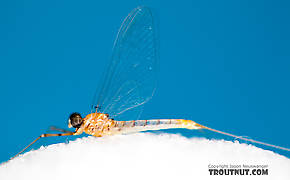 View 14 Pictures
View 14 Pictures
 View 14 Pictures
View 14 PicturesCollected July 11, 2017 from the North Fork Stillaguamish River in Washington
Added to Troutnut.com by Troutnut on July 12, 2017
Added to Troutnut.com by Troutnut on July 12, 2017
9 Underwater Pictures of Epeorus Mayflies:

In this picture: Mayfly Genus Epeorus (Little Maryatts) and Mayfly Family Baetidae (Blue-Winged Olives).
StateNew York
LocationMongaup Creek
Date TakenApr 19, 2006
Date AddedApr 22, 2006
AuthorTroutnut
CameraPENTAX Optio WPi
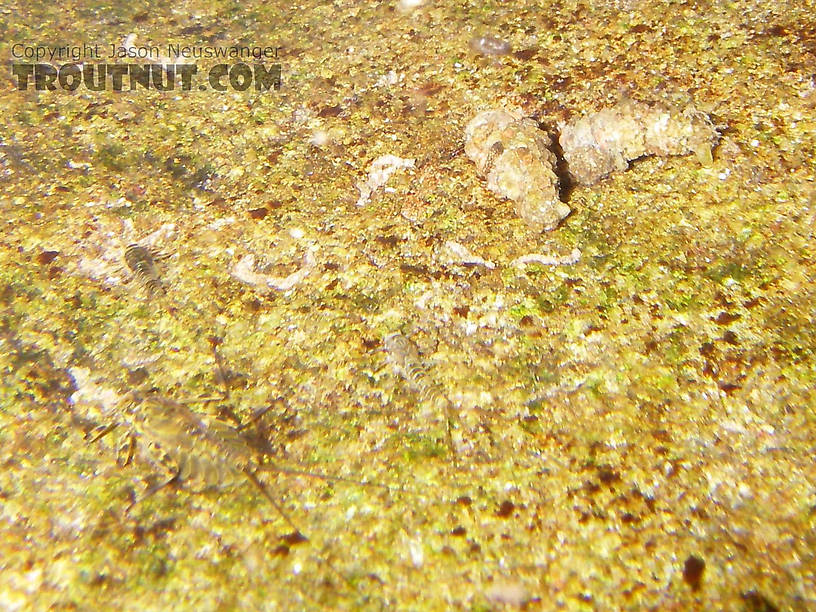
In this picture: Mayfly Genus Epeorus (Little Maryatts), Insect Order Trichoptera (Caddisflies), and Mayfly Family Baetidae (Blue-Winged Olives).
StateNew York
LocationMongaup Creek
Date TakenApr 19, 2006
Date AddedApr 22, 2006
AuthorTroutnut
CameraPENTAX Optio WPi
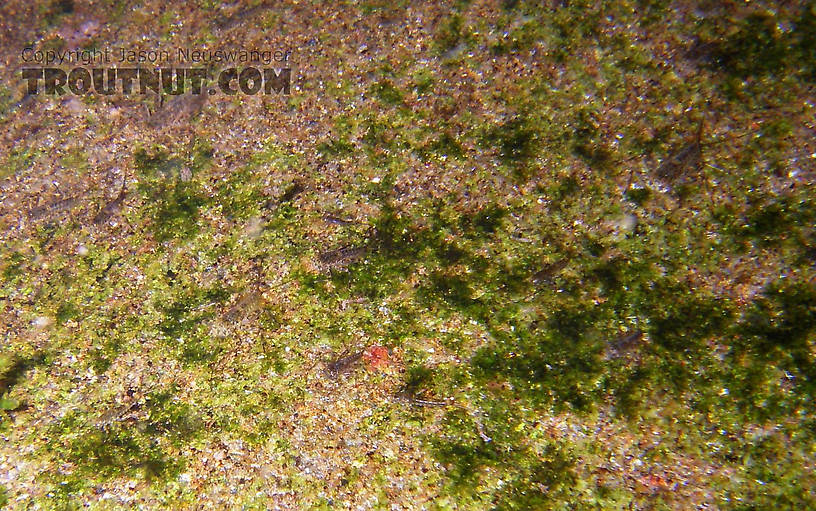
In this picture: Mayfly Genus Epeorus (Little Maryatts) and Mayfly Family Baetidae (Blue-Winged Olives).
StateNew York
LocationMongaup Creek
Date TakenApr 19, 2006
Date AddedApr 22, 2006
AuthorTroutnut
CameraPENTAX Optio WPi
Recent Discussions of Epeorus
Distance between the eyes of male Epeorus
Posted by Troutnut on May 3, 2007
There has been some discussion here before about Epeorus identification, especially the distance between the eyes of the adult males, which is one identifying characteristic. The keys say that the distance should be "less than the width of the median ocellus," but I have collected a few male duns that didn't quite fit that requirement.
We figured they were Epeorus anyway, so it's not a big deal, but a new specimen I collected sheds a bit of light on the question.
I collected a dun whose eyes were also a bit far apart, which you can see here:
http://www.troutnut.com/specimen/681
Then it molted into a spinner:
http://www.troutnut.com/specimen/682
The spinner's eyes were really almost touching, well within the description of the genus. So that answers our question: the duns may have a little wider spread and the gap will close up in the spinners.
ReplySynonym of vitreus 3 Replies »We figured they were Epeorus anyway, so it's not a big deal, but a new specimen I collected sheds a bit of light on the question.
I collected a dun whose eyes were also a bit far apart, which you can see here:
http://www.troutnut.com/specimen/681
Then it molted into a spinner:
http://www.troutnut.com/specimen/682
The spinner's eyes were really almost touching, well within the description of the genus. So that answers our question: the duns may have a little wider spread and the gap will close up in the spinners.
I believe rubidus = vitreus
ReplyThere is 1 more topic.
Your Thoughts On Epeorus:
Top 10 Fly Hatches
Top Gift Shop Designs
Eat mayflies.
Top Insect Specimens
Miscellaneous Sites
Troutnut.com is copyright © 2004-2024 Jason
Neuswanger (email Jason). See my FAQ for information about use of my images.
 privacy policy
privacy policy
